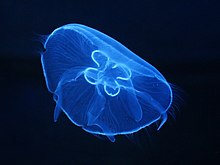Radiata
The division of living beings into systematics is a continuous subject of research. Different systematic classifications exist side by side and one after the other. The taxon treated here has become obsolete due to new research or is not part of the group systematics presented in the German-language Wikipedia.

As Radiata ( "Radiation animals"; from lat. Radius "ray") which are radial symmetry built eumetazoa referred, the term today has mainly a historical significance. The group includes the two tribes of the cnidarians (Cnidaria) and the comb jellyfish (Ctenophora) (according to an isolated view also the Placozoa ). In the past, the Radiata were viewed as a natural relational group and compared to the bilaterally symmetrical animals (Bilateria). Today, however, they are viewed as an artificial grouping because more recent morphological and molecular biological studies have shown that there is no closer relationship between the cnidarians and the comb jellyfish.
The term is often used synonymously with the term Coelenterata .
Traditional view
The term radiata can be traced back to the early 19th century, where it was popularized by Georges Cuvier . Cuvier summarized different animal groups as radiata, which have an apparently disordered, diffuse nervous system and appeared to be organized in a comparably simple manner. Among other things, he listed echinoderms and nematodes as radiations.
The use of the term was later restricted to the cnidarians and the comb jellyfish. The two tribes have long been considered sister groups because they share some anatomical features that are lacking in other tissue animals. They have a very thin body wall that is only made up of cells from two cotyledons ( endoderm and ectoderm ). The inside of the body is almost completely filled with a gelatinous mass ( mesoglea ). In addition, cnidarians such as cortisoid jellyfish have an apparent radial symmetry, so their body shows several mirror planes and not just one, as in the Bilateria. In the meantime, however, this assumption is no longer tenable.
Modern perspective
The relationships between the Bilateria , Cnidaria and Ctenophora are now mainly explained by the Planulozoa concept . Accordingly, the Cnidaria are the sister group of the Bilateria.
Similarities between these groups ( synapomorphies ) can be found in the structure of the sperm , the epithelia and the nervous system in cnidaria larvae and original bilateria. In addition, molecular biological studies show that the Bilateria are related to the Cnidaria. Both groups are compared to the ctenophores together. Large differences in the anatomy of the Cnidaria and the Ctenophora are now known. Strictly speaking, ctenophores do not show a radial, but a biradial symmetry . In addition, they have glue cells (collocytes) for catching prey , which were created independently of the stinging cells (cnidocytes) of the cnidaria. The relationship between the Placozoa and the aforementioned groups has not yet been clarified.
literature
- Le règne animal; distribué d'après son organization; for the service of the base of the history of the animaux et d'introduction of the anatomy comparée. 4 volumes. Paris 1817 (German: Das Thierreich, arranged according to its organization: as the basis of the natural history of animals and introduction to comparative anatomy. 6 volumes. Brockhaus, Leipzig 1831–1843).
- Hynek Burda, Gero Hilken, Jan Zrzavý: Systematic Zoology . UTB, Stuttgart 2008, ISBN 978-3-8252-3119-4
